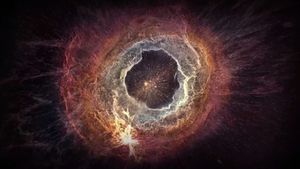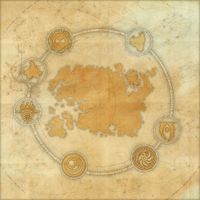Lore:Aurbis
The Aurbis is the name given to the chaos, or totality, from which the cosmos was formed by Anu and Padomay. For all intents and purposes, it is the universe, encompassing the Void and all Planes of Existence including Mundus, Aetherius, and the planes of Oblivion.[1]
Many sources describe the structure of the Aurbis as a wheel: Mundus is the hub, the empty spaces within it are the planes of Oblivion, the rim encompasses the realms of Aetherius, and the emptiness beyond it is the Void. The eight spokes connecting the rim to the hub represent the Eight Divines that played a major part in Creation.[2][3][4][UOL 1] The Eight Divines are also depicted as planets, orbiting Nirn and its moons at the center of the Aurbis.[5] The sun, Magnus, was created when the god Magnus fled Mundus to Aetherius, and the stars were formed by the Magna Ge who followed.[6] The Eye of Magnus was, among other ideas, theorized by the College of Winterhold to contain the entirety of the Aurbis. Though this theory was considered dubious at best, close observations on the Eye yielded no evidence to the contrary.[7]
The Alessian, perhaps Marukhati,[8] Arch-Prelate Fervidius Tharn describes the Aurbis as comprising "sheaths" within an overarching "integument". Through the intervention of the Magna Ge Mnemoli and a particular manipulation, called the "Hurling Disk", of the identity between the circle of the Aurbis and the Tower, the Arch-Prelate apparently believed it would be possible to detach a sheath from the Aurbis' integument and "twist" it to provoke the Dragon Break of the Middle Dawn.[9] An Argonian source similarly mentions the existence of Aurbic "skeins" that can be "disjoined" by powerful mages.[10]
The planes of Aurbis are made up of different reality layers, spatially overlapping sections which can be accessed via the use of magic which shifts beings and objects between them, things shifted to a different layer generally can't be perceived or interacted with by those who lack the necessary arcane means.[11][12][13].[14]
According to the Daedric Prince Ithelia, mortals, by their very existence and lives, help preserve and maintain Aurbis, every child born, war fought, or field plowed by mortals, helps stabilize reality itself. It is said that mortals were designed as servants to perform tasks that maintain reality and so, the limitations that constrain them, such as the inability to comprehend and traverse the Many Paths, were placed upon them intentionally. This truth, Ithelia claims, is generally kept from mortals, to minimize the risk of them disrupting the plans of those who benefit from this secret. Despite this, there are certain individuals who have been shown to not be bound by at least some of the usual mortal limitations, being able to comprehend and traverse the Many Paths without issue.[15]
Possibilities scatter across the Aurbis, each defined by distinct choices and outcomes that lead to different realities. This web is called the Many Paths, which have been likened to both a spiderweb that formed within a diamond, interweaving lines within a grander fixed shape, and a halo of possibilities and alternate fates that surround reality. It is said that within the Many Paths all things are possible, things which might not be real in one reality might be real within the Paths, it is even possible to encounter realities where concepts such as magic or Daedra might not exist, or realities that are a dark reflection of the world, empty and timeless and filled with darkness, the world one sees when looking into a mirror. Each reality along the Many Paths contains its own version of each entity, be they mortal or Daedra, even deities such as the Daedric Princes have their own alternate versions within the realities. These alternate versions are said to be "reflections" of one another, different in some ways, like images in a cracked mirror, but originating from the same seed[15][16][17]
Contents
Gallery[edit]
Notes[edit]
- The adjective Aurbic is sometimes used to describe a type of magical force associated with the fundamental structure of the Aurbis.[18][19] A related term is Aurbisal, implying "of the Aurbis".[20]
- Demiprince Fa-Nuit-Fen converted his Oblivion realm, Maelstrom, into a gauntlet of arenas. After the Vestige conquered the arena, the Barons Who Move Like This were released. Fa-Nuit-Hen used the freed barons as officers in his Maelstrom Army. He planned to conquer the Aurbis with this army, enthralling the champions of Maelstrom Arena and forming a force of the greatest warriors in existence.[21]
- The term multiverse has also been used to refer to the various realms that exist within the Aurbis. The concept of the Many Paths extends beyond that structure.[22][23][UOL 2]
See Also[edit]
- For game-specific information, see the Elder Scrolls Online article.
References[edit]
- ^ The Monomyth
- ^ The 36 Lessons of Vivec — Vivec
- ^ Mythic Dawn Commentaries — Mankar Camoran
- ^ The Book of the Dragonborn — Prior Emelene Madrine
- ^ Orrery in Oblivion
- ^ Exegesis of Merid-Nunda — Phrastus of Elinhir
- ^ Phinis Gestor's dialogue in Skyrim
- ^ Vindication for the Dragon Break — Fervidius Tharn, Arch-Prelate of the Maruhkati Selective
- ^ On the Detachment of the Sheath — Arch-Prelate Fervidius Tharn
- ^ Crafting Motif 9: Argonian Style — Doctor Alfidia Lupus
- ^ Leramil's dialogue during A Hidden Fate in ESO
- ^ Meln the Mouthless' dialogue during A Hidden Fate in ESO
- ^ A Hidden Fate quest in ESO
- ^ Blightcrown's dialogue in ESO
- ^ a b Ithelia's dialogue in ESO
- ^ Leramil's dialogue in ESO
- ^ Beragon's dialogue in ESO
- ^ The Doomcrag loading screen in ESO
- ^ Loremaster Celarus' dialogue in ESO: Summerset
- ^ Azandar's dialogue in ESO
- ^ Fa-Nuit-Hen's dialogue in ESO: Orsinium
- ^ Luna Beriel's dialogue in ESO
- ^ Sotha Sil's dialogue in ESO: Summerset
Note: The following references are considered to be unofficial sources. They are included to round off this article and may not be authoritative or conclusive.
|
||||||||||||||||||||||

